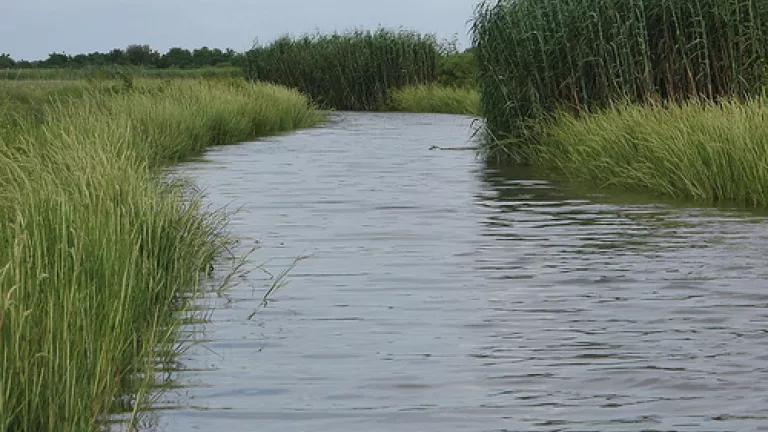
Everybody loves before and after pictures, and during my recent trip to the Gulf of Mexico, I got to see the equivalent: I traveled by boat through a struggling marshland and then I floated through lush, green, wetlands full of grasses, birds, and even a few alligators.
The fading marshlands suffered from decades of oil and gas drilling and levee projects. The vibrant wetlands, meanwhile, sit east of the Mississippi River where no energy development has occurred and where healthy doses of sediment have prevented erosion. Here is what they look like:
I also traveled through a wetland that was on the mend—part of a $25 million restoration project underway in Bayou DuPont that illustrates how we can get from the struggling to the lively kind of wetlands.
Seeing the various wetlands, I was struck by how quickly life rejuvenates in the Gulf—given the right conditions. It’s obvious we know what it takes to bring wetlands back from the brink. And since healthy wetlands are the cornerstone to the region’s multimillion dollar fisheries and recreation industries, we have no excuse to leave the Gulf to wither after the BP oil disaster.
People I spoke to in the region agree. They say the spill devastated untold miles of wetlands. But the flip side is it may also galvanize the nation to revive the Gulf Coast once and for all.
This week, Navy Secretary Ray Mabus, who was appointed by President Obama to develop a recovery plan for the Gulf of Mexico, is expected to release his report on how to restore the region. If it is going to succeed, it has to think big when it comes to reviving the wetlands.
Louisiana’s wetlands were ailing before the Deepwater Horizon disaster. They were like a man struggling with heart disease who gets hit by a car: the underlying condition makes it much harder to recover from the trauma.
In the case of the wetlands, the problem wasn’t disease; it was starvation. As I explain in my new book, In Deep Water: The Anatomy of a Disaster, the Fate of the Gulf, and How to End our Oil Addiction, Gulf wetlands need a steady diet of sediment to keep barrier islands and grasses from washing away, and the Mississippi River used to provide plenty of nourishment.
But decades of engineering projects changed all that. There are now 40,000 dams along the river, and more than half of natural sediment flows are trapped behind four major dams way up north in Minnesota and North Dakota. Meanwhile, because levees redirect the river’s flow, 120 million tons of sediment is getting shot out into the deep water instead of spread along the shallow coastline. As many as 250 million tons of sediment fail to reach the marshlands every year.
In addition to starving, the wetlands have been carved up by fifty years of oil and gas companies laying pipelines and dredging channels have carved the wetlands up further.
And then the Deepwater Horizon blowout occurred, coating hundreds of miles of wetlands with thick heavy strokes of oil. The oil kills the grasses that hold the marshes in place, accelerating the loss of wetlands. This is what oil does to grass:

This isn’t an abstract problem. It cuts right to the heart of the Gulf’s economic lifeblood. “Ninety-seven percent, by weight of the commercial fish and shellfish landings from the Gulf of Mexico are species that depend on estuaries and adjacent wetlands for some point of their life cycle,” says David Westerholm, director of the Office of Response and Restoration for NOAA.
People I spoke to in South Louisiana take the loss of the wetlands very seriously and fear that the BP spill may be the final blow. But as the restoration project at Bayou DuPont shows, we know how to solve this problem. We just have to take a comprehensive approach and pool as many resources as possible.
One pitfall I have seen in previous cases is that the damages paid by the polluter get spread too thin. The money gets divided up among states, then the states divide it up among various agencies and local communities. Leaders can return home and say, “Look how much money I secured for us,” and everybody does their own little piece of restoration.
But the science shows that dozens of postage stamp projects is not what the Gulf needs. It needs systematic changes. The money BP owes in damages should be used for the large-scale solutions, not small fixes that politicians can claim as spoils of war.
It would also help to redirect the way penalties are paid. Under the Clean Water Act and the Oil Pollution Act, penalties typically go to the national treasury, but there are efforts underway to pass a special law that would allow penalties to go back to the natural resource that was destroyed.
This added funding could jumpstart major restoration in the Gulf—if there is political will for it.
At this point, it is a question of leadership. We already know what the science dictates. I attended a presentation in New Orleans where the speaker said we have known for decades what the wetlands need, and she showed slide after slide of terrific, science-based restoration plans that have been proposed and shelved year after year.
Hopefully, the terrible reality of the BP oil spill will end this log jam, and we will finally do right by the Gulf.
